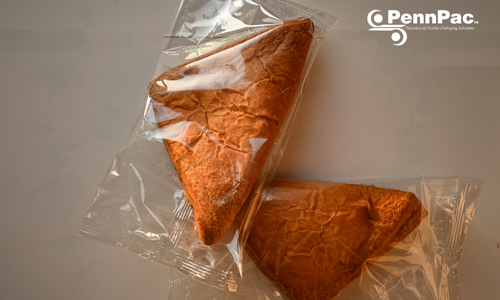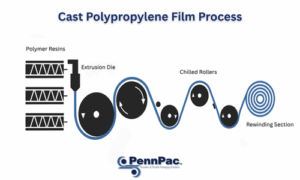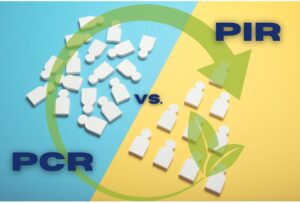
Key Takeaways
- Cast PP (or CPP) films offer superior clarity and enhanced mechanical properties. Ultimately, making them ideal for high-quality packaging.
- They provide significant cost-efficiency through with lower production costs.
- CPP films have excellent barrier properties. Furthermore, ensuring extended shelf-life and better product protection.
- The versatility and environmental sustainability of CPP films make them a preferred choice across various industries.
Table of Contents
Understanding Cast Polypropylene (CPP) Films
What are CPP Films?
CP films are a type of polypropylene film produced through the cast film extrusion process. This process involves melting polypropylene resin, extruding it through a flat die, and cooling it rapidly on chilled rollers . As such, forming a thin film with uniform thickness and clarity. Unlike blown PP films, which are produced through a different method, CPP films generally offer superior clarity and better mechanical properties. Ultimately, making them ideal for high-quality, transparent packaging solutions.
- Manufacturing Process:
- Melting polypropylene resin.
- Extruding it through a flat die.
- Cooling rapidly on chilled rollers.
For more details on the production process, visit Europlas, and Jwell Group.
Difference from Other PP Films
The key differences between CPP films and blown PP films lie in clarity, thickness control, and mechanical properties. CPP films provide:
- Superior Clarity: This makes them more visually appealing for high-end products.
- Better Thickness Control: This ensures consistency and reliability in packaging applications.
- Enhanced Mechanical Properties: These properties contribute to the durability and performance of the film.
Cost-Efficient CPP
Cost Advantages
One of the standout features of CPP films is their cost-efficiency. The manufacturing process for CPP films is simpler and quicker, which contributes to reduced production costs. Additionally, unlike blown film methods, cast films tend to generate less material waste. This means manufacturers not only save money on materials. Furthermore, reduce overall production expenses.
- Reduced Material Wastage: This is a significant factor in lowering costs and increasing overall productivity.
Economic Benefits for Businesses
The economic benefits of using CPP films extend beyond immediate cost savings. CPP films contribute to long-term savings through:
- Improved Yield Rates: Higher yield rates mean more products per production cycle.
- Reduced Downtime: Faster production processes lead to less downtime, increasing operational efficiency.
These factors have a positive impact on manufacturers’ budgets. Ultimately, allowing for competitive pricing strategies without compromising quality.
Advantages of Cast Polypropylene
Performance Benefits
Superior Clarity and Aesthetic Appeal
Cast PP films deliver superior clarity and shine thanks to their molecular arrangement during the casting process. This enhances product presentation and attracts consumer attention, which is crucial in competitive retail environments.
- Visual Appeal: Clear and glossy films improve branding and marketing efforts.
Enhanced Barrier Properties
Cast PP films possess exceptional barrier properties against moisture and oxygen. As such, making them ideal for preserving perishable goods.
- Extended Shelf-Life: Products can maintain freshness for longer periods.
- Better Protection: These films keep products safe during transport and storage, reducing spoilage.
Durability and Flexibility
Resistance to Tearing and Punctures
The strong resistance of CPP films to tearing and punctures guarantees durability in various environments. This property ensures that packaged goods remain protected throughout their journey from manufacturing to consumers.
Flexibility in Packaging Applications
Cast PP films are adaptable to a variety of packaging formats. They can be easily sealed, printed, and laminated, making them suitable for diverse packaging applications. This flexibility enhances their appeal for businesses looking to tailor solutions to specific industry requirements.
Environmental Impact
Recyclability
Cast PP films are inherently recyclable. Ultimately, contributing to a lower environmental footprint compared to multilayer or metalized alternatives. This makes them an attractive option for eco-conscious companies looking to implement sustainable practices in their packaging.
Learn more at PennPac PIR vs. PCR.
Sustainable Packaging Solutions
The energy-efficient production process of cast PP films generates less waste, supporting sustainable packaging initiatives. Switching to cast PP films can be a significant step toward improving your company’s sustainability record.
Comprehensive Cast PP Benefits
Versatility in Applications
Cast PP films are used across a wide range of applications, including:
- Food Packaging: To maintain freshness and extend shelf life.
- Medical Supplies: Providing essential protection for sensitive materials.
- Consumer Goods: Enhancing shelf appeal and product visibility.
- Industrial Products: Offering robust packaging solutions for heavy-duty items.
Customization options such as varying thickness, layers, and coatings further enhance their versatility, allowing them to cater to specific industry needs. For more examples, see Flexible Packaging Films for Food & Beverage.
Improved Product Protection
Cast PP films excel in maintaining product integrity. Their mechanical strength and moisture barrier properties ensure that contents remain safe and secure during transit.
Enhanced Consumer Appeal
The high-quality clarity and surface gloss provided by cast PP films contribute significantly to attractive product presentation. This aesthetic appeal plays a vital role in branding and enhancing consumer engagement, making products more enticing on retail shelves.
Case Studies and Examples
To illustrate the benefits of cast PP films, here are two real-world examples:
Example 1: Food Packaging Company
A food packaging company switched from traditional packaging materials to cast PP films and noticed substantial improvements:
- Extended Shelf-Life: Products stayed fresh for longer durations.
- Reduced Costs: The company saved about 20% in packaging expenses, while improving quality.
Example 2: Medical Supplies Manufacturer
A medical supplies manufacturer utilized cast PP films due to their superior barrier properties, which led to:
- Increased Product Protection: Essential supplies were kept sterile and secure.
- Improved Aesthetics: The clear films enhanced brand visibility and consumer confidence.
“Since switching to cast PP films, our packaging costs have decreased by 18% while maintaining top-notch product quality.”
Conclusion
In summary, the benefits of CPP films encompass cost-efficiency, exceptional performance, durability, and environmental sustainability. These films are not just advantageous for production; they contribute significantly to product protection and consumer appeal.
Considering these advantages, it’s time to evaluate how cast PP films can meet your packaging needs.
Discover how cast PP films can transform your packaging strategy. Contact us today for a personalized consultation on optimizing your packaging solutions.
FAQ
What are Cast PP Films?
Cast PP films are polypropylene films created through the cast film extrusion process, offering superior clarity and mechanical properties suitable for high-quality packaging applications.
How do Cast PP Films differ from Blown PP Films?
Unlike blown PP films, cast PP films provide better clarity, more consistent thickness control, and enhanced mechanical properties, making them ideal for applications requiring high transparency and durability.
What are the cost benefits of using Cast PP Films?
Cast PP films are cost-efficient due to a simpler and quicker manufacturing process, reduced material wastage, improved yield rates, and decreased production costs, leading to overall savings for businesses.
Are Cast PP Films environmentally friendly?
Yes, cast PP films are recyclable and produced through energy-efficient processes that generate less waste, supporting sustainable packaging initiatives and reducing environmental impact.





